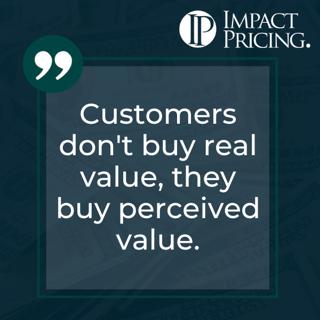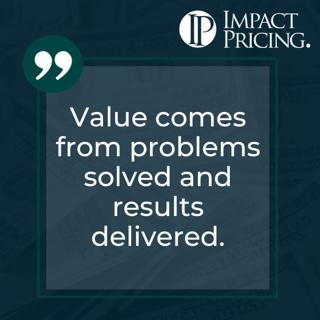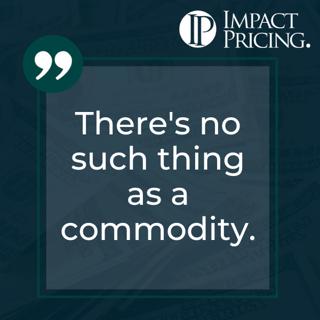
Blogcast: Why Your NRR Isn't Better
This is an Impact Pricing Blog published on September 28, 2023, turned into an audio podcast so you can listen on the go. Read Full Article Here: https://impactpricing.com/blog/why-your-nrr-isnt-better/ If you have any feedback, definitely send it. You can reach us at mark@impactpricing.com. Now, go make an impact. Connect with Mark Stiving: Email: mark@impactpricing.com LinkedIn: https://www.linkedin.com/in/stiving/
3 Nov 20233min

Pricing Table Topics: King of Diamonds – Customers Buy Perceived Value
This one is the King of Diamonds from the Impact Pricing card deck. We know that customers trade money for value. They're buying value, but what kind of value? There's lots of ways to break value up, but in this meme we want to talk about the difference between perceived value and real value. Let's imagine there is this true measurable amount of value. For example, maybe I'm selling a gold coin and that gold coin actually has a value that I could look up online and say, what's the value of this coin? Got it. But when I'm selling a service or I'm selling a product, I can't just go look up online and say, what's the value of this? Especially to me, because I don't know how I'm going to use it. I don't know how it's going to create more profits. And so, what I'm willing to pay is based completely around how much value do I think I might be getting from that product. Now here's a great example. Imagine that you're selling a coffee cup. So what's the value of a coffee cup to somebody, right? Maybe it depends upon what the design is on the front, or who really wants it, or what the lid looks like. I mean, there's lots of different factors that might define what someone's willing to pay. And so, they say, yeah, I'd pay 10$ for that coffee mug. But what if there was a gold coin at the bottom of the coffee mug when they bought it, and that gold coin is worth 1, 000$. They just bought 1, 000$ gold coin for 10$ because their perception was, hey, it's a coffee mug. They didn't perceive the value of the gold coin at the bottom. They're not buying the true value, they're only buying the value they know about. How do we use this information? Well, it means to us that we have to be marketing and selling the true value of our product. Because if we're not communicating our value well to our buyers, they're not using it as they make decisions on should they buy our product or not, and how much would they be willing to pay for it. We hope you enjoyed this example of Pricing Table Topics. What you just heard was done without a script. If you want to get better at speaking about pricing and value, grab a deck of our cards, pick a card, read the saying, and then talk for one to two minutes about what that card says. You'll become a better speaker and expert. If you have any questions or feedback, please email me, mark@impactpricing.com. Now, go make an impact. Connect with Mark Stiving: Email: mark@impactpricing.com LinkedIn: https://www.linkedin.com/in/stiving/
1 Nov 20233min

Leveraging the Power of Selling and Leadership to Win at Higher Prices with Scott K. Edinger
As a consultant, author, advisor, and speaker, Scott K. Edinger creates positive change for clients and is recognized as an expert in the intersection of leadership, strategy, and sales. He is the author of The Growth Leader: Strategies to Drive the Top and Bottom Lines. In this episode, Scott delves into the powerful link between good selling and good leadership. He highlights the significance of persuading others to embrace your vision and strategies as a leader, much like enabling people to invest in the desired outcomes that your product can potentially offer them. Why you have to check out today's podcast: Deep dive into how selling and leadership closely interrelate with each other Find out why sales experience is the underrated differentiator Learn how expanded solutions make way for higher margins "If you really want to think about pricing, then it's not a spreadsheet exercise. It's an exercise in thinking about how do we create value in the sales process. And that will determine how much you can charge." - Scott K. Edinger Topics Covered: 01:24 - How Scott found himself in pricing 02:48 - A backstory of how he started in HR and landed in pricing 03:09 - A deep dive into why selling and leadership are closely related 08:06 - How to sell at a higher margin without too much discounting 10:15 - Questions to ask your team to uncover if they're bringing value to people's sales experience 12:11 - Making customers find aha moments in your offer/service 13:49 - How you make people choose you over competing options 15:16 - Building trust and what it takes to build it at this point in time 17:26 - Discussing about a faulty assumption on the idea of 'land and expand' 19:47 - Sales experience in relation to customer experience in the concept of 'land and expand' 22:08 - What drives expansion 23:51 - The 3 Cs of inspiring and communicating 25:31 - Scott's response to Mark's comment: Here's what I love about those three C's. They ought to be in chapter one 26:04 - Scott giving his best pricing advice Key Takeaways: "The sales experience is the first mile of the customer experience highway. And if it's not good, people get off at exit one and have a customer experience someplace else." - Scott K. Edinger "If you want to sell at a higher margin, sell at greater margins or sell expanded solutions, then your ability to help customers to think differently, to help them to see problems that they hadn't anticipated or solutions that they hadn't considered, that part of the sales experience has to be a priority. That can become a differentiator." - Scott K. Edinger "One of the things that I think really drives it [expansion] is if you recognize the sales execution in your business; sales becomes the execution of your strategy." - Scott K. Edinger People/Resources Mentioned: The Growth Leader: Strategies to Drive the Top and Bottom Lines by Scott K. Edinger: https://www.amazon.com/Growth-Leader-Strategies-Drive-Bottom/dp/1799746208 Sell Is Human: The Surprising Truth About Moving Others by Daniel H. Pink: https://www.amazon.com/Sell-Human-Surprising-Moving-Others/dp/1594631905 Rethinking the Sales Force: Redefining Selling to Create and Capture Customer Value by Neil Rackham: https://www.amazon.com/Rethinking-Sales-Force-Redefining-Customer/dp/0071342532 McKinsey: https://www.mckinsey.com Gartner Research: https://www.gartner.com/en/products Connect with Scott K. Edinger: Website: https://www.scottedinger.com/ LinkedIn: https://www.linkedin.com/in/scott-edinger/ Connect with Mark Stiving: LinkedIn: https://www.linkedin.com/in/stiving/ Email: mark@impactpricing.com
30 Okt 202329min

Blogcast: Learning from iPhone Pricing
This is an Impact Pricing Blog published on September 21, 2023, turned into an audio podcast so you can listen on the go. Read Full Article Here: https://impactpricing.com/blog/learning-from-iphone-pricing/ If you have any feedback, definitely send it. You can reach us at mark@impactpricing.com. Now, go make an impact. Connect with Mark Stiving: Email: mark@impactpricing.com LinkedIn: https://www.linkedin.com/in/stiving/
27 Okt 20232min

Pricing Table Topics: King of Hearts – Value Comes from Problems Solved and Results Delivered
This one is the King of Hearts from the Impact Pricing card deck. We often think about, what is value? And we think of value-based pricing, it's what's a customer or buyer willing to pay. And so, their willingness to pay has everything to do with how they perceive the value of our product. So, what is that value? Well, it turns out nobody actually wants to buy your product. What they really want to buy are solutions to their problems. And so, how do we think about that? If we want to think about value, let's start by thinking about what's the problem, or problems, our buyers are really facing. When we deeply understand that and we can articulate that back to the buyer, oftentimes, they can't articulate it, we build great relationships. We resonate with them. And then we can start talking, hey, if you solve this problem, what kind of results might you expect? And when they can articulate those results and we put them in numerical format, some kind of quantity, then we can usually use business acumen in a B2B space to say, great, here's how much additional profit that would generate for you. Or even better than that, ask them, how much additional profit do we think that would generate for you? And maybe we hold their hand while they do the math. But regardless, the point of this whole meme is that value always comes back to, my buyer has a problem, they want to solve the problem, and what's the result they're trying to achieve when they solve this problem. We hope you enjoyed this example of Pricing Table Topics. What you just heard was done without a script. If you want to get better at speaking about pricing and value, grab a deck of our cards, pick a card, read the saying, and then talk for one to two minutes about what that card says. You'll become a better speaker and expert. If you have any questions or feedback, please email me, mark@impactpricing.com. Now, go make an impact. Connect with Mark Stiving: Email: mark@impactpricing.com LinkedIn: https://www.linkedin.com/in/stiving/
25 Okt 20232min

Why Is Net Revenue Retention (NRR) Your Most Important Growth Metric? Latest Report with Steven Forth
Steven Forth is Ibbaka's Co-Founder, CEO, and Partner. Ibbaka is a strategic pricing advisory firm. He was CEO of LeveragePoint Innovations Inc., a SaaS business designed to help companies create and capture value. In this episode, Steven delves into a report that includes research analysis on the Net Revenue Retention growth of various industries. The report explores the impact of factors such as organizational design, package architecture, pricing metrics, among others. Additionally, it highlights the role of churn, customer success, and a dedicated team in driving this growth. Why you have to check out today's podcast: Gain important insights when it comes to Net Revenue Retention [NRR] performance growth for different industries based from a research report Understand how a company's organizational design contributes to a low or high Net Revenue Retention [NRR] Learn how churn, customer success, and dedicated team greatly affects your Net Revenue Retention "You need to have two pricing metrics so that you can grow in package. So, some form of usage-based pricing is going to be absolutely critical to a successful NRR growth." - Steven Forth Topics Covered: 01:55 - What drives Ibbaka and PeakSpan to work together and come out with a report that gives insights to the pricing industry 06:01 - Why not include price increase when considering net revenue retention [NRR] 09:25 - Differentiating upsell from cross-sell 10:58 - Two reasons why NRR by API is high 15:07 - An explanation on what those chart and numbers mean on page 29 of the report 18:10 - Explanation to Mark's observation on the package architecture with one data showing huge NRR 20:48 - The meaning behind having independent modules but low NRR [in reference to the two sections in the report] 23:04 - Steven's response to Mark's suggestion of redoing the chart [good, better, best version] 26:17 - Touching on the different pricing metrics for AI [ what he says about pricing based on input/output tokens] 28:50 - Pricing a solution and a platform [case in point: Zoom] 33:23 - Explanation to Mark's question in reference to page 39 of the report about Pricing Metrics for API Integrators: Are APIs supposed to be a pricing metric? 35:10 - Two important points that these data report generates [also touching on churn, customer success, and dedicated team and how it affects NRR] 40:36 - Steven's best pricing advice Key Takeaways: "If you've designed your packaging and pricing so that you don't have growth in package, don't have upsell, and don't have cross sell, then you know in advance that the net revenue retention is going to be less than a hundred percent because there is always going to be some churn." - Steven Forth "API as a pricing metric is associated with high NRR performance. Why is that? And I think the answer is because of the verticals where it's used." - Steven Forth "There's lots of companies that are not very good at cross-sell. So the fact that, if you're using independent modules and you have low NRR, that suggests that you're not doing a very good job with cross-sell." - Steven Forth "When you really get into this data, even in the verticals that are generally having low net revenue retention, there are a few companies that have high net revenue retention. So you can't just blame it on your vertical because there are probably some of your competitors in your vertical that do have maybe not 130, but 110 to 120% net revenue retention." - Steven Forth "The companies that have the best NRR performance are the companies that have dedicated NRR teams." - Steven Forth Resources/People Mentioned: PeakSpan: https://www.peakspancapital.com Webex: https://www.webex.com Zoom: https://zoom.us Connect with Steven Forth: LinkedIn: https://www.linkedin.com/in/stevenforth/ Email: steven@ibbaka.com Connect with Mark Stiving: LinkedIn: https://www.linkedin.com/in/stiving/ Email: mark@impactpricing.com
23 Okt 202341min

Blogcast: Four Ways to Grow a Customer
This is an Impact Pricing Blog published on September 14, 2023, turned into an audio podcast so you can listen on the go. Read Full Article Here: https://impactpricing.com/blog/four-ways-to-grow-a-customer/ If you have any feedback, definitely send it. You can reach us at mark@impactpricing.com. Now, go make an impact. Connect with Mark Stiving: Email: mark@impactpricing.com LinkedIn: https://www.linkedin.com/in/stiving/
20 Okt 20233min

Pricing Table Topics: King of Spades – There's No Such Thing As a Commodity
This one is the King of Spades from the Impact Pricing card deck. Of course there's no such thing as a commodity. Well, many salespeople, many business people think they're selling a commodity. And what that really means is that they just have to charge the same price that everybody else charges. But is that really true? In my view of the world, if you're charging the exact same price, that means you're not adding any value. Why would I buy from you versus somebody else? And in truth, there are ways that you can add value to almost anything. For example, if you were to go to two different vendors of gold coins online today, you'll find they're not identical prices. But isn't gold a commodity? Well, maybe it's approximately the same price, but there's a difference in price based on the service level of the vendor. Based on something that they're giving above and beyond. Maybe it's free shipping. Maybe it's storage. Maybe it's the niceness of the salespeople. Regardless of what it is, there's something there that says, Hey, I get to charge a little bit more than my competition because my product, my service, something is better. And what we need to do, even if we're selling a true commodity, something that is physically identical to somebody else's, we can differentiate it through other means. So, we should always be focused on the fact that we are not selling a commodity. In fact, my view of the world is, if you're claiming that you sell a commodity, then we don't need you as a salesperson. And we don't need you as a product manager. Because pretty much everybody has the same thing, why would we need you to help us? So, accept that fact and drive hard, what's different? Where's your differentiation? What can you do that's better so that you can charge a higher price? We hope you enjoyed this example of Pricing Table Topics. What you just heard was done without a script. If you want to get better at speaking about pricing and value, grab a deck of our cards, pick a card, read the saying, and then talk for one to two minutes about what that card says. You'll become a better speaker and expert. If you have any questions or feedback, please email me, mark@impactpricing.com. Now, go make an impact. Connect with Mark Stiving: Email: mark@impactpricing.com LinkedIn: https://www.linkedin.com/in/stiving/
18 Okt 20233min






















